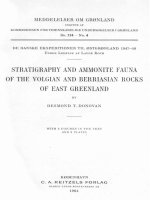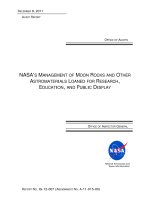Sedimentary rocks
Bạn đang xem bản rút gọn của tài liệu. Xem và tải ngay bản đầy đủ của tài liệu tại đây (2.33 MB, 45 trang )
Sedimentary Rocks
Deposited on or Near Surface of Earth by
Mechanical or Chemical Processes
What Rocks Tell Us
Rock Type
Igneous
Sedimentary
Metamorphic
How Classified
Composition
Texture
What it Tells Us
Tectonic Setting
Cooling History
Chemical
Composition
Surface
Environment
Grain Size
Energy of
Environment
Composition
Original Rock Type
Mineral Makeup
Temperature,
Pressure
Texture
Degree of Change
Types of Sedimentary Rock
• Clastic (terrigenous or detrital)
–
–
–
–
Conglomerate or Breccia
Sandstone
Siltstone
Shale
• Chemical/biochemical
– Evaporites
– Carbonate sedimentary rocks (limestones and
dolostone)
– Siliceous sedimentary rocks
• Organic (coals)
– Other - ironstones
Sedimentary Rocks are the
Principal Repository for
Information About the
Earth’s Past Environment
Depositional environments in ancient sediments are
recognized using a combination of sedimentary facies,
sedimentary structures and fossils
Environmental Clues in
Sedimentary Rocks
• Grain Size - Power of Transport Medium
• Grading - Often Due to Floods
• Rounding
• Sorting
}
• Cross-bedding - Wind,Transport,
Reworking
Wave or Current
Action
Environmental Clues in
Sedimentary Rocks
• Fossils
– Salt Water - Corals, Echinoderms
– Fresh Water - Insects, Amphibians
– Terrestrial - Leaves, Land Animals
• Color And Chemistry
– Red Beds - Often Terrestrial
– Black Shale - Oxygen Poor, Often Deep Water
– Evaporites – Arid Climates
Sedimentary Rocks
Clastic Rocks
• Made of Fragmentary
Material
• Deposited by
– Water (Most
Common)
– Wind
– Glacial Action
– Gravity
Biochemical
Sedimentary Rocks
• Evaporation
• Precipitation
• Biogenic Sediments
Clasts (larger pieces, such as sand or
gravel)
•
Clasts and matrix (labelled),
and iron oxide cement
(reddish brown color)
Terrigenous (also called detrital or clastic)
• Terrigenous
sedimentary rocks
are classified
according to their
texture (grain size):
Gravel:
Grain size greater than 2 mm
1. If rounded clasts = conglomerate
2. If angular clasts = breccia
•Sandstones
•Conglomerates
Rounded fragments
•Breccia
Angular fragments
CLASTIC ROCKS
• Formed from broken rock fragments weathered
and eroded by river, glacier, wind and sea waves.
These clastic sediments are found deposited on
floodplains, beaches, in desert and on the sea
floors.
solidify
(mudstone)
Clastic rocks
• Clastic rocks are classified on the basis of the grain
size: conglomerate, sandstone, shale etc.
Clastic Rocks
Classified by:
•
Grain Size
•
Grain Composition
•
Texture
Degree of roundness helps in knowing the
distance of transportation (method of erosion)
•Angular clasts- short distance transport from the source
•Rounded clasts- long distance transport
Sediment Sizes and Clastic
Rock Types
Rock Type
Sediment
Grain Size
Shale
Clay
less than 0.001 mm
Siltstone
Silt
.001-0.1 mm
Sandstone
Sand
.01-1 mm
Conglomerate Gravel
1mm +
Sedimentary rocks made of silt- and clay-sized
particles are collectively called mudrocks, and are
the most abundant sedimentary rocks.
Bedding or Stratification
•
•
•
•
•
Almost Always Present in Sedimentary Rocks
Originally Horizontal
Tilting by Earth Forces Later
Variations in Conditions of Deposition
Size of Beds (Thickness)
– Usually 1-100 Cm
– Can Range From Microscopic to 50m
GRADED BEDDING
Fine gravelly lithounit
Medium-coarse sandy
lithounit (cross stratified)
Laminated layers of fine silt and clay
Cross-stratified sst.
Paleo-flow from
right to left
Ripple marks
Mud cracks
Biogenic structures
Foot prints
Diagenesis
Compaction
+
Cementing
Quartz
Calcite
Iron Oxide
Clay
Glauconite
Feldspar
Alteration
• Limestone - Dolomite
• Plagioclase – Albite
Recrystallization
• Limestone
Diagenesis is any chemical, physical,
or biological change undergone by a
sediment after its initial deposition and
during and after its lithification.
Cementation
Clastic particles ranging from siltsize to boulder-size may be
deposited on the sea floor. As
they are buried, ion-laden sea
water may deposit minerals in
the pore spaces between the
grains, thus effectively
cementing them together. By
this process the sediments
become rocks such as
siltstone, sandstone and
conglomerate.
Compaction
Clastic particles smaller than
silt, such as mud are deposited
on the sea floor. As they are
buried, the weight of overlying
sediments presses downward
on the mud particles and
compacts them, resulting in the
formation of rocks such as
claystone,mudstone or shale.
TYPES OF SEDIMENTARY ROCKS
Clastic rocks
•
•
•
•
Chemical & Organic rocks
Sandstones
Conglomerates
Breccia
Shale/mudstones
Evaporites rocks
These rocks are formed
due to evaporation of saline
water (sea water)
eg. Gypsum, Halit
(rock salt)
Carbonate rocks
Organic rocks
Form basically from
CaCO3 – both by
chemical leaching and
by organic source
(biochemical)
eg.
Limestone; dolomite
Form due to
decomposition of
organic remains
under temperature
and pressure eg.
Coal/Lignite etc.
Chemical Sediments
Evaporites -Water
Soluble
• Halite
• Gypsum
• Calcite
Precipitates
Example: Ca(sol'n) +
SO4 (Sol'n) = CaSO4
• Gypsum
• Limestone
• Iron Formations
Alteration After
Deposition
• Dolomite
Biogenic Sediments
• Limestone - Shells,
Reefs, Etc.
Organic Remains
• Coal
• Petroleum
EVAPORITIC ROCKS
These rocks are formed within the a depositional basin
from chemical substances dissolved in the seawater or
lake water.
Gypsum
CaSO4.2H20
Halite
(NaCl)









